If you’ve ever been to a range, the scenario is often the same: Shooters line up in a designated lane and shoot from a standing position. If on a rifle range, your rifle is placed on a bench or rest and fired from that position. While these positions favor accuracy and safety, they aren’t overly practical for defensive shooting. If preparing for the harsh reality of a gunfight or practical/defensive shooting competition, unconventional shooting positions are a necessity to add to your toolbox. Let’s discuss the ins and outs of unconventional shooting positions, why you should practice them, and how to do so safely and realistically.
What are unconventional shooting positions?
In the most basic sense, unconventional shooting positions are just that – unconventional. To comprehend what constitutes “unconventional,” let’s define what is “conventional.” Conventional shooting positions, at least for my purposes, comprise four basic positions: standing, kneeling, sitting, and prone.
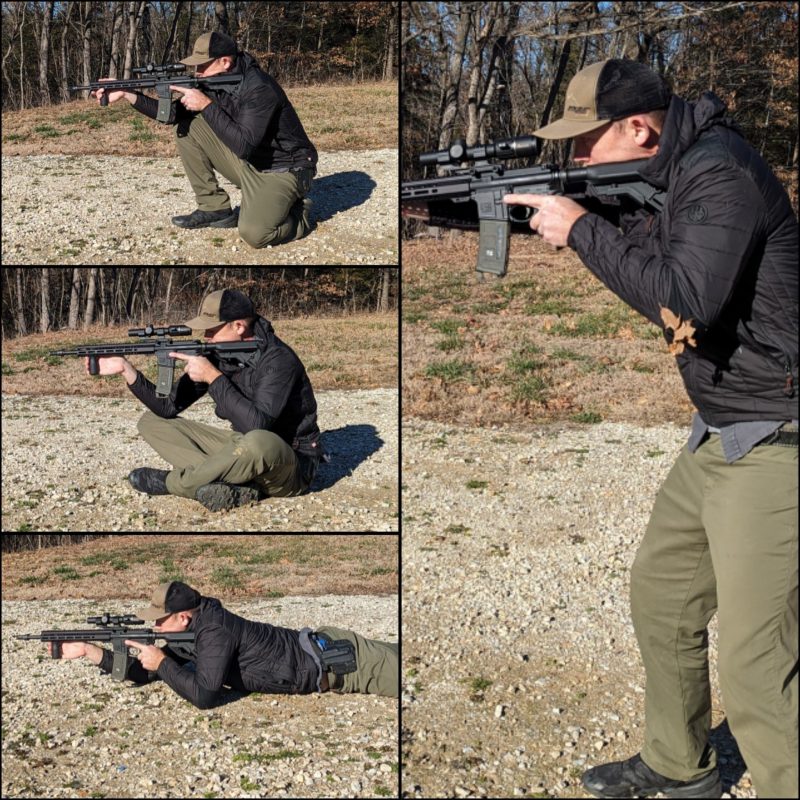
Conventional shooting positions are practical and, as with any technique, have applications that make them appropriate for a particular situation. However, not all of these positions are advantageous when working around cover, obstacles, or other real-world nuances. Unconventional shooting positions are advantageous because they allow you to work around cover, whereas conventional shooting positions may expose you to a threat unnecessarily. These positions increase stability when requiring an exceptionally difficult shot. In some instances, they may have a narrow but practical application.
Unconventional Shooting Positions
I’m not naïve enough to claim this is an exhaustive list of unconventional shooting positions. However, these are positions and techniques that I’ve learned from other instructors or implemented over the years. There are plenty of unconventional shooting positions; however, unconventional must adhere to the caveat of practical. There’s stuff out there that looks cool but is impractical.
Rollover Prone
The prone shooting position is one of the most stable unaided shooting positions. While versatile and practical for long-range engagements, it’s not necessarily the easiest position to get out of — or into. Furthermore, pistol shooting in conventional prone isn’t the most stable position nor is it comfortable. Rollover prone is a surprisingly versatile pistol position worth adding to your repertoire of unconventional shooting positions.
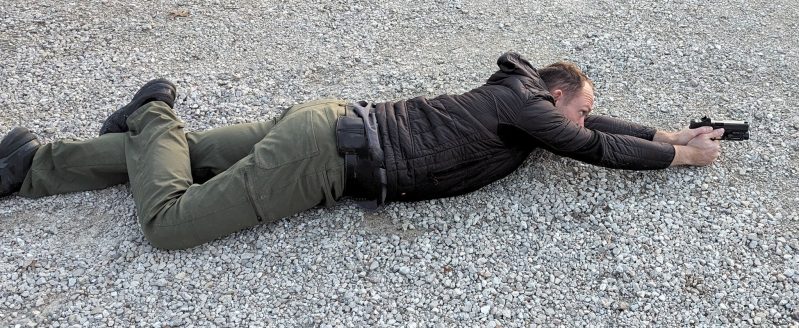
Rollover prone is primarily intended for pistol work. Rather than lying flat on your stomach, roll towards your dominant shoulder and on your side. Take your non-dominant foot and knee and bend it until your foot is at your knee. This supports your body and keeps you rolled on your side. Keep the pistol vertical and place the magazine baseplate onto the ground. If properly positioned, your head settles behind the sights, and you can make effective and surprisingly accurate shots at distances out to 50 yards. With some practice, 100-yard shots — even with iron sights — aren’t unrealistic in this position. This is also a great position for working around low cover since it angles most of your body behind available cover or concealment.
Fetal “Prone”
Over the years, I’ve taken many firearms courses and trainings. While I’ve been blessed with some fantastic instructors, some stood out as exceptional. I attended several courses with Carlos Kerley (he was my firearms instructor in two law enforcement academies) over the years and have tried to emulate his teaching style with my instruction. While I took a great deal from his teachings, this particular position, “Fetal” prone as I refer to it, is one that’s stuck with me for years.
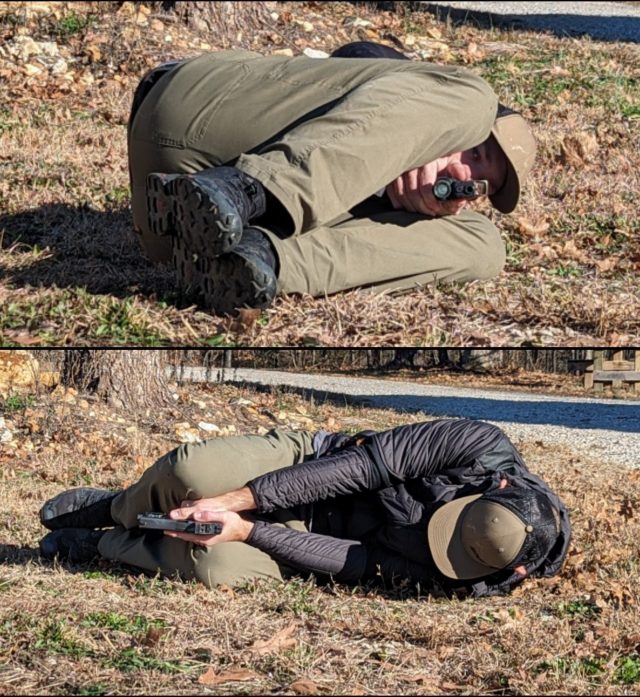
Fetal prone is an exceptionally stable handgun shooting position requiring little effort to assume. Furthermore, it’s simple. The shooter lies on their left or right side depending on the environment. They bring their knees into the body like a fetal position. With muzzle discipline paramount, place both hands between your knees in a two-handed shooting grip. Use your knees to gently squeeze your hands and hold them in place. The fetal prone position requires some practice since the sights are oriented horizontally, not vertically. If using a red dot, things are a little easier. When I did it for the first time in Kerley’s academy course, it was surprisingly easy to accomplish 100-yard shots. This position won’t disappoint.
Supported Rollover Kneeling
I don’t particularly remember where I picked up this method, but I recall the first time I used it. In 2017, I responded to the sound of a burst of gunfire nearby while walking to my patrol car. Upon our arrival, we were engaged with gunfire from a homicide suspect attempting to ambush my partner and me. After a brief exchange of projectiles, the suspect barricaded in a house. I used this position after deploying my patrol rifle. I’ve since referred to this position as “supported rollover kneeling.” The available cover, a truck’s engine block, required I use this position to maintain a view of the suspect’s basement stronghold.
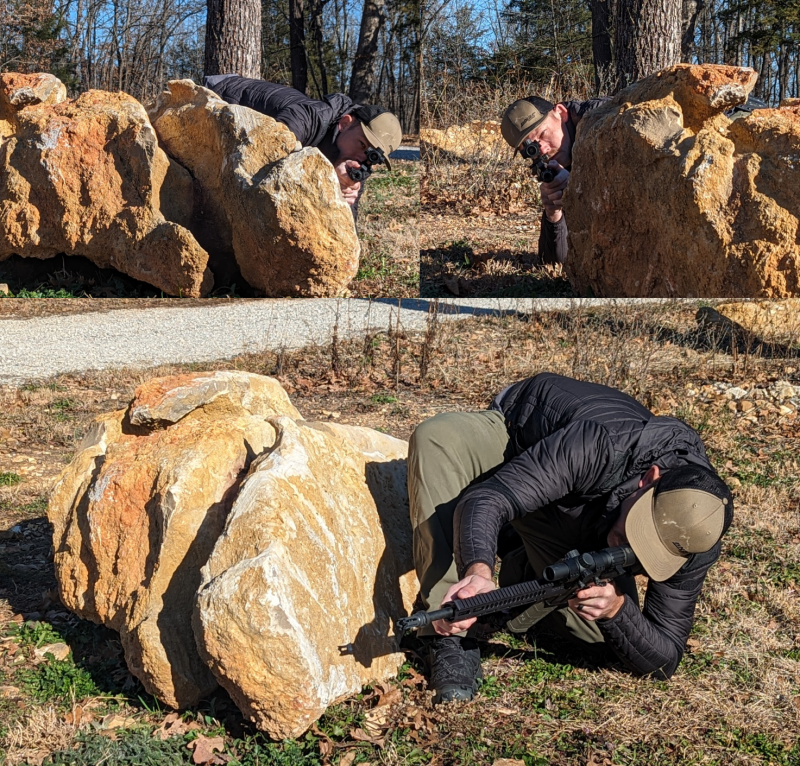
This position isn’t for everyone and requires practice. However, I’ve successfully used this position in training and the field to support my rifle where cover is short or I have to peer under something. The dominant elbow acts as a brace against the ground while the non-dominant arm braces against the inside of the non-dominant leg. These points of contact stabilize your shooting position. With the addition of an appropriately fitted sling, it’s relatively comfortable and can be held for a surprisingly long time.
Shooting After the Fall
Ideally, gunfighting should remain vertical while fighting with our hands is horizontal. However, real-world environments may not be conducive to this. If in a fight that escalates to lethal force, it’s possible we may be fighting from or knocked to the ground. Among the breadth of unconventional shooting positions, shooting after being knocked to the ground is one that is less about technique than it is about exposure to this position.
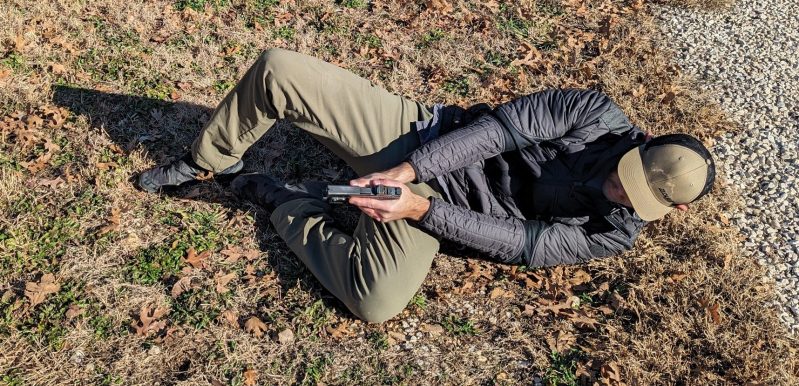
While many of us envision shooting from the ground as something from a Michael Mann film (I think of the nightclub scene in Collateral), it’s not always that simple. You may not land on your back. It may be your side, your hip, or your knees. The key takeaway is to practice these positions. Furthermore, shooting from your back requires a focus on muzzle discipline and safety. When drawing, our muzzle shouldn’t point towards, or sweep, any of our legs. While some think shooting someone in the leg isn’t lethal, there are some vital hydraulic and mechanical (e.g. arteries, veins, and bones) components we want to avoid modifying with a high-velocity projectile.
While not necessarily an “unconventional” shooting position, shooting from both knees is worth trying in addition to working from your back and side. Shooting from both knees has practical applications. If working from your back, you may end up on your knees while trying to get on your feet. It’s worthwhile shooting from this position as part of the transition of getting up and becoming mobile again.
Caution With Unconventional Shooting Positions
While I’ve stressed the importance of safety when practicing and employing unconventional shooting positions, I should also mention a point about muzzle awareness. With the proliferation of rifle and handgun optics, scope over bore offset is a legitimate concern — especially with rifles. When employing these skills, be conscious about where your muzzle is relative to the bore. A clear sight picture doesn’t translate to a clear shot. The scope over bore offset may lead to unintended consequences if you don’t properly work around cover.

Practice Breeds Competence, Competence Breeds Confidence
While not all of these unconventional shooting positions are possible for some of us, they’re worth trying and practicing. In the real world, cover isn’t a perfect square at the exact height to cover our entire body. Cover is wheel wells, engine blocks, brick retaining walls, trees, terrain, and so on. Work with what you have in front of you under the circumstances. By employing unconventional shooting positions, you expand your capabilities to adapt to adverse environments and conditions. While not comprehensive, these unconventional shooting positions have served me well over the years and provided adequate protection and stable foundations on the range and in the real world. As the saying goes – practice breeds competence, competence breeds confidence. By trying and practicing these positions, you’re building that confidence to respond safely – and capably – in a lethal encounter.


